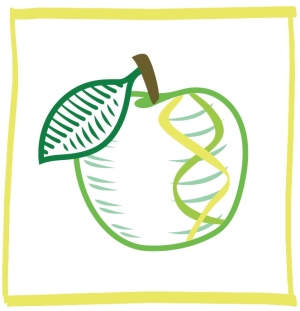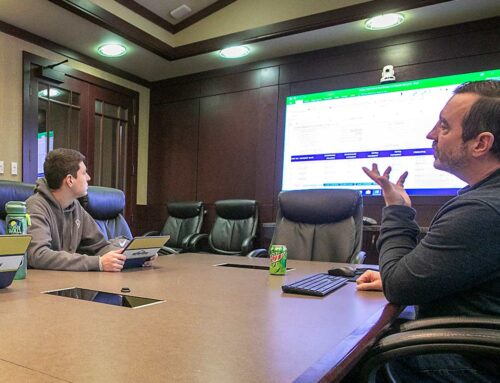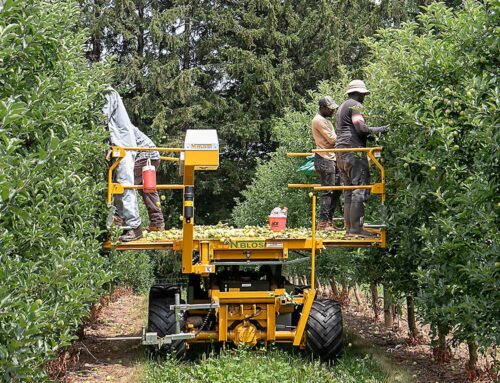
by Mike Willett, Vice President for Scientific Affairs, Northwest Horticultural Council
Does it make economic sense to plant an Arctic apple orchard?
According to Okanagan Specialty Fruits the benefits of planting their recently deregulated genetically modified apples are legion.
Mothers will never have to toss a half-eaten brown hulk again. Growers and packers won’t see handling damage or visible browning from storage disorders.
Retailers and food service operators will have a more attractive product with less shrink. Great product vistas will open up for food processors, and there will be dancing on the catwalks, assuming that is allowed under Good Manufacturing Practices.
However, to make all those sectors happy, a grower first has to make a decision to plant Golden Delicious or Granny Smith apples, thus far the only varieties for which Okanagan has received FDA approval.
Based on a 2011 study of Honeycrisp orchard establishment costs by Washington State University, a grower will first face costs of more than $25,000 per acre to plant and grow these cultivars through the first five years.
Can establishment costs be justified and, by corollary, returns to the grower increased, when the Arctic apple only adds value by bringing non-browning to the table?
Will returns be sufficient to allow these cultivars to be grown (partly or wholly) for processing, a non-traditional choice as a primary marketing outlet for Pacific Northwest growers?
Last fall, many saw a Golden Delicious orchard in Mattawa, Washington, lying on the ground, half-buried and unharvested, because it was determined that potential returns did not justify the cost of harvest and packing. And, based on reports from across the Northwest, that orchard was emblematic of decisions being made about Golden Delicious this year.
Granny Smith production has been level to slightly declining in recent years in Washington State. In California, Granny production shrank to less than half of the 1.5 to 1.6 million carton peaks of the mid-2000s.
Non-browning
How important is non-browning to apple consumers? Unfortunately, there is no independent research to answer this question. But non-browning or resistance to browning is not novel in apple cultivars.
The most prominent example would be Cortland, a cross of McIntosh and Ben Davis developed by Professor S.A. Beach in a conventional breeding program at Cornell University’s New York State Agricultural Experiment Station.
Like Golden Delicious and Granny Smith, it was also first planted in the 19th century. It is widely considered to be the most resistant to browning of all apple varieties currently in commerce.
Cortland was selected to be an improved McIntosh-type apple, but, even given its resistance to browning, it has not replaced McIntosh. In 2008, 2.5 million cartons of Cortland were produced in New York State, perfect for sliced consumption in kabobs and salads, according to the New York Apple Association.
Of course, there are other apples that are naturally resistant to browning, some even introduced in this century.
Some are better adapted to certain growing areas than others, but none of them were primarily selected for release because of their resistance to browning.
Non-browning, while a notable characteristic, is not the highest priority trait for selection in conventional breeding programs, according to publications from the Specialty Crop Research Initiative’s RosBREED project.
For apple breeders, texture, postharvest quality, and flavor were the top three selection criteria. According to work done by WSU’s Dr. Karina Gallardo and colleagues, higher ranking of these criteria represents the apple breeder’s attention to consumer interests. Appearance, including flesh browning, is in the lower tier of selection criteria.
Science versus perception

(TJ Mullinax/Good Fruit Grower illustration)
The Northwest Horticultural Council has always been careful to point out that the “Pacific Northwest tree fruit industry strongly supports novel research in tree fruit genetics and genomics.”
That includes the application of modern biotechnology to solving agricultural production problems.
But, marketing is about perception. Any concerns raised here are not based on an industry perception of health risk, but rather based on the realities we see growers and marketers facing in a very competitive apple market.
Clearly, some apple buyers have no problem with the type of genetic manipulation that yielded the Arctic apples, but you can easily find comments on the web such as this as well:
“Now, it’s only an apple but why do I want to buy an apple that is GM modified for cosmetic reason only? It might not be an immediate risk to my health but do I know about the LONG TERM risk? Remember Thalidomide?”
In contrast, on websites with public comments about Honeycrisp, the posts are overwhelmingly about love. Some Honeycrisp commenters were under-impressed because they apparently prefer a tarter apple, but there were no posts raising neonatal birth defects as an issue.
Clearly, reprinting random public comments only proves that some heightened level of concern exists. Sentiments such as the one highlighted do, to an unprecedented degree in the history of apple variety introduction, demonstrate that a segment of potential consumers has a strong negative opinion about an apple that they have never even seen on a grocery store shelf.
Persons with negative opinions regarding genetically modified foods are often dismissed as anti-science or misinformed.
However, food choices are not necessarily solely based on detached scientific assessment. If Arctic apples are to be planted, how hard do apple marketers want to work to overcome negative consumer attitudes, and how much does this negativity potentially limit market potential?
The biggest wild card is in international markets. How a genetically modified apple will fare in the court of international regulatory processes and public opinion and whether all apples will be mistakenly conflated to be Arctic is unknown.
Like most cultivars grown in the Pacific Northwest, Golden Delicious and Granny Smith exports are significant. On average, over the last six years just under half of the roughly 10 million carton Golden Delicious crop has been exported annually, with about 3.5 million cartons of that total destined for Mexico.
Over a similar period, about 25 percent of the Granny Smith crop is exported annually, with the largest markets, Canada and Asia, each taking about one million cartons.
In not wanting to raise a complex issue at an official level in any export market, quiet discussions with friendly sources have been held. It is clear that some countries will require identity preservation, either to prevent GMO apples from entering or to allow clear segregation for consumers.
As an example of those types of official concerns, in January’s plant quarantine negotiations that resulted in an agreement to allow U.S. access to China for all apple cultivars, the Chinese side raised concerns with the pending approval of a GMO apple.
At those meetings, USDA officials indicated to their Chinese counterparts that GMO apples would not be exported to China. Northwest apple shippers have effective and accurate traceability systems.
However, neither the U.S. government nor our industry has been provided a lab methodology by the developer to allow molecular verification of genetic status.
If our industry’s latest experience with Listeria concerns in export markets serves as an example, some countries seem to be looking for protectionist opportunities to restrict market access. Creating uncertainty about the GMO status of U.S. apples could be one way.
The other uncertainty is consumer perception in those markets. While our experience in this arena has been limited to the few occasions when pesticide residues on exported fruit exceed locally allowable standards, in a number of Pacific Rim countries, backlash from consumer groups is common.
Many times this backlash is aimed at chemicals that are also used in that country’s own agricultural production systems and deemed safe on other crops grown there.
These are generally not carefully reasoned expressions of concern and could easily be directed at what would likely be the non-existent presence of GMO apples.
In a recent edition of this magazine Todd Fryhover, Apple Commission president, posed the following important questions:
—Can and will other apple producing countries “throw U.S. apples under the bus” to promote their own products? and
—Whose responsibility is it to convince consumers that Washington apples aren’t altered and remain the symbol of health and nutrition?
Of course, if the grower community makes the decision that planting Arctic apples does not make sense, all of this consumer and export uncertainty is avoided.
Good Fruit Grower welcomes reader comments on this issue. You can send a letter to the editor or post a comment below.






You have articulated all the reasons that irrationality could hurt the apple industry based on this particular innovation. My hope is that the real advantages of this slight change in an apple might lead to a consumer breakthrough on “GMOs” – maybe I’m way too optimistic. I get the fact that the apple industry does not particularly want to be involved in this controversy. But do you want to shut off what solutions that technology might provide down the line?
Steve:
Thanks for the note. I am sure that you would agree it is not a requirement that every new technology be embraced by the target market. Take the Edsel, for example.
For over 10 years, the apple industry of the U.S. and Canada has advised the ‘Arctic’ developers that the market risk of introducing their technology appeared to substantially outweigh the benefits of non-browning which is not a new attribute of apple. After all, there are many cultivars (Cortland, Cosmic Crisp, Opal, Greenstar, etc), the products of conventional selection or breeding, which could meet niche consumer interest in non-browning. As you know, industry advice was ignored.
As to the question regarding support for biotechnology, with the encouragement of apple growers Washington State University has become a center of excellence for Rosaceae genetics and genomics with the goal of understanding more and becoming smarter about cultivar development. The industry position on ‘Arctic’ apple should not be perceived as opposition to science and technology which can help select improved cultivars that are valued for their fruit quality by consumers around the world. The goal is to expand the pool of consumers, not restrict it for limited and questionable benefit.
In my book Apples of North America I emphasized consumer taste in the broad spectrum of thousands of apple varieties but once again, time, energy and money has been wasted to keep the consumer eating with the eyes, not the mouth. Remember once green skinned apples were considered unripe and unsalable until Marie Ann “Granny” Smith threw those French crabapple parings out her back door!
I was just going to comment that Tom Burford, in his Apples of North America on page 111, discusses the heirloom apple, Maiden Blush, that remains bright white as it dries, then I saw Tom himself was here participating!